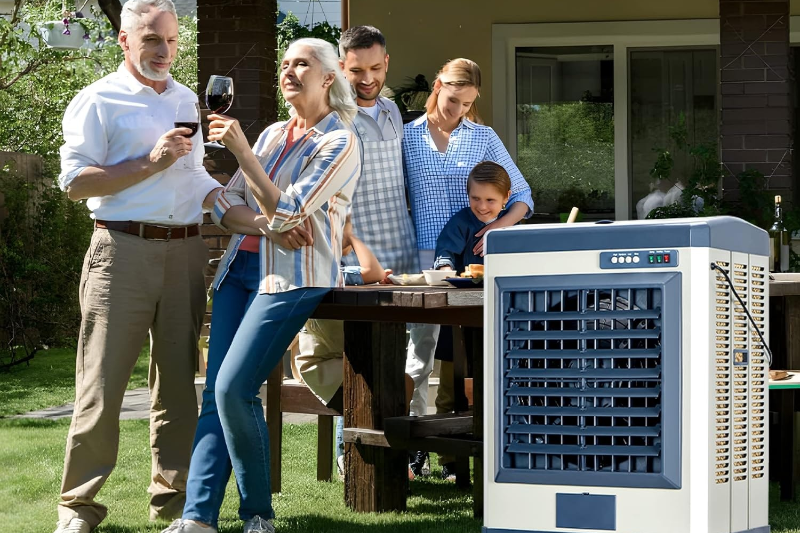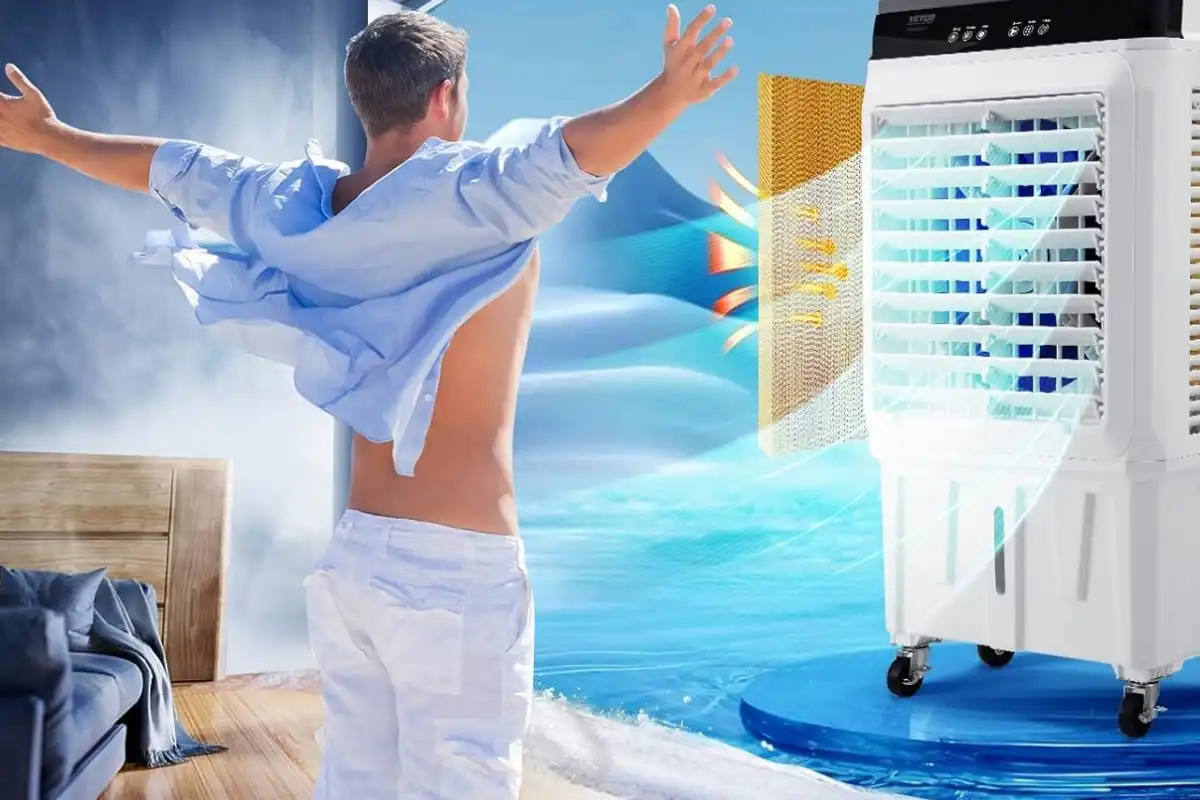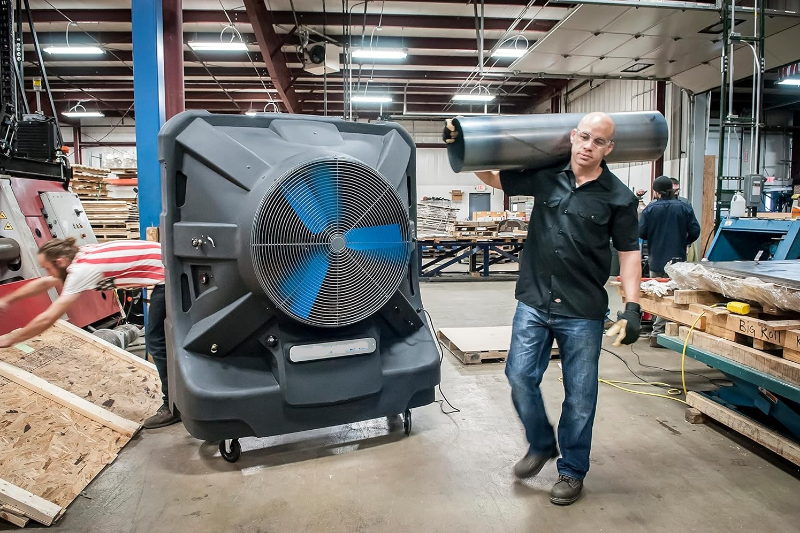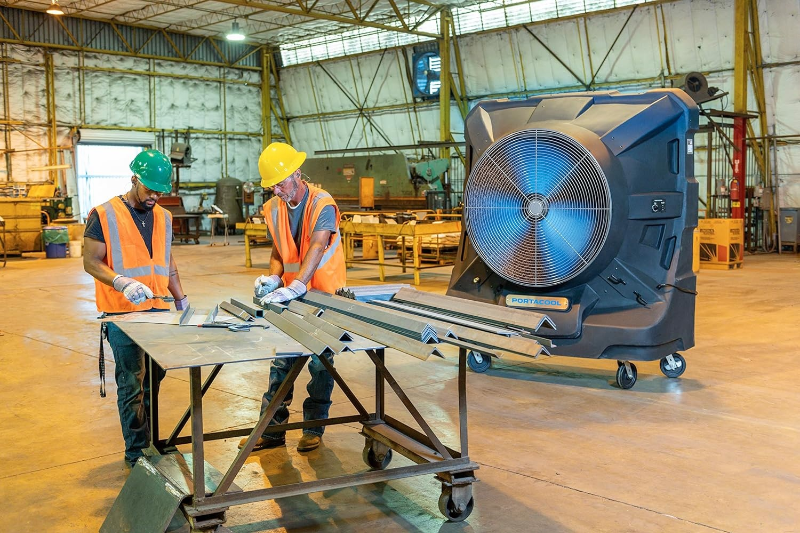Table Of Contents
In the scorching heat of summer, the quest for a reliable and energy-efficient cooling solution is a common pursuit. Enter evaporative air conditioning, a technology that harnesses the power of evaporation to cool your surroundings effectively. Read on to learn more!
Understanding Evaporative Air Conditioning

Definition and basic principles
At its core, evaporative air conditioning relies on evaporation to create a cooling effect. Unlike traditional air conditioners that use refrigerants, evaporative coolers leverage the physics of water changing states—from liquid to vapour. This process, in turn, cools the air, providing a refreshing and energy-efficient alternative.
Critical components of evaporative cooling systems
Evaporative coolers consist of essential components such as a water reservoir, a pump, and evaporative pads or media. The pump circulates water from the reservoir into the pads, typically made of materials that facilitate efficient evaporation. A fan then draws warm air through the moistened pads, causing the water to evaporate and significantly lowering the air temperature.
Distinction from traditional air conditioning
While both evaporative and traditional air conditioning aims to cool indoor spaces, they employ different mechanisms. Conventional AC units use refrigerants and a complex cycle of compression and expansion to cool the air. In contrast, evaporative coolers rely on natural and environmentally friendly evaporation, making them a greener alternative.
The Evaporation Process

Water as the cooling agent
The heart of evaporative cooling lies in water’s unique ability to absorb and release large amounts of heat during the phase change from liquid to vapour. As water evaporates, it absorbs heat from the air, leading to a drop in temperature. This phenomenon is the foundation of the cooling effect generated by evaporative air conditioning.
Role of evaporative pads or media
Evaporative pads play a crucial role in the cooling process. Composed of materials with high water absorbency, these pads ensure efficient evaporation and act as the medium through which warm air passes. This strategic combination of water and specialised pads optimises the cooling performance of evaporative systems.
Air circulation mechanism
Evaporative coolers utilise a fan to distribute the cooled air throughout the space. The fan draws warm air through the moistened pads, resulting in evaporating cooling. The result is a continuous circulation of fresh, cool air, creating a comfortable indoor climate.
Advantages of Evaporative Cooling

Energy efficiency
One of the standout features of evaporative air conditioning is its impressive energy efficiency. Unlike traditional AC units that consume significant amounts of electricity, evaporative coolers use only a fraction of the energy. The primary energy expenditure is attributed to the fan and water pump, making them a cost-effective and environmentally friendly cooling solution.
Environmental sustainability
Evaporative cooling aligns with environmentally conscious practices. By eschewing harmful refrigerants and relying on the natural evaporation process, these systems reduce greenhouse gas emissions and limit the overall environmental impact of cooling technologies.
Cost-effectiveness
Beyond energy efficiency, evaporative cooling systems often boast lower operational costs than traditional air conditioners. The simplicity of their design, coupled with fewer mechanical components, translates to reduced maintenance expenses, making them an attractive option for budget-conscious consumers.
Health benefits
Evaporative coolers introduce fresh, humidified air into the indoor environment. This cools the air and helps alleviate respiratory discomfort associated with dry conditions. Individuals with respiratory issues may find relief as evaporative cooling maintains optimal humidity levels, promoting a healthier living or working environment.
Versatility in different climates
Unlike some cooling technologies that struggle in extremely dry or humid conditions, evaporative air conditioning performs exceptionally well in arid climates. Its cooling efficiency tends to increase in drier conditions, making it a versatile and effective solution for various geographic locations.
Limitations and Considerations

Humidity impact on performance
While evaporative cooling excels in dry climates, its effectiveness diminishes in highly humid environments. The cooling process relies on the evaporation of water, and when the air is saturated with moisture, the cooling effect is limited. Understanding the local climate is crucial when considering the adoption of evaporative air conditioning.
Geographic suitability
The performance of evaporative cooling systems varies based on geographic factors. Areas with low humidity levels and high temperatures are ideal for these systems. Before installation, it’s essential to assess the location’s climate to determine the suitability and potential benefits of evaporative air conditioning.
Maintenance requirements
Although evaporative coolers generally have lower maintenance costs, regular upkeep is essential for optimal performance. Periodic cleaning of the pads, checking and adjusting water levels, and inspecting the pump and fan ensure longevity and sustained efficiency. Understanding the maintenance requirements is critical to enjoying the full benefits of evaporative air conditioning.
Initial installation costs
While the operational costs of evaporative cooling are favourable, it’s essential to consider the initial installation expenses. Factors such as system size, the complexity of installation, and additional features can influence the upfront costs. However, many users find that the long-term savings in energy bills offset the initial investment.
Comparison with other cooling technologies
Before committing to an evaporative cooling system, comparing its performance, energy efficiency, and cost with other available cooling technologies is valuable. Traditional air conditioning, heat pumps, and other innovative solutions should be considered based on individual needs and preferences.
Applications of Evaporative Air Conditioning

Residential cooling solutions
Evaporative coolers are well-suited for residential cooling, providing an efficient and cost-effective alternative to traditional AC units. They are particularly effective in single-family homes, apartments, and other living spaces where a constant flow of fresh, cool air is desired.
Commercial and industrial uses
Businesses and industries benefit from the scalability and cost-effectiveness of ducted evaporative air conditioning. Warehouses, factories, and large commercial spaces can maintain comfortable working conditions without the substantial energy costs associated with conventional cooling systems.
Agricultural and data centre cooling
Evaporative cooling finds applications in diverse sectors, including agriculture and data centres. Farmers use these systems to create optimal conditions for crops, while data centres utilise them to manage heat generated by electronic equipment efficiently.
Evaporative cooling in dry climates
In arid regions, where traditional air conditioning may be less effective, evaporative cooling shines. Its reliance on dry air for efficient evaporation makes it an attractive solution for cooling homes, businesses, and public spaces in desert climates.
Integration with HVAC systems
Many HVAC systems integrate evaporative cooling technology. This allows you to enjoy the benefits of both systems, optimising energy efficiency and overall comfort.
Tips for Effective Evaporative Cooling
Proper system sizing
The right size for the evaporative cooling system is crucial for optimal performance. Undersized units may struggle to cool the space adequately, while oversized units could lead to excess humidity. Consultation with a professional to determine the appropriate system size is prudent.
Regular maintenance practices
Regular maintenance is paramount to ensure consistent and efficient operation. Cleaning evaporative pads, inspecting the water pump, and monitoring water levels are routine tasks that contribute to the longevity and effectiveness of the system.
Optimal use in specific weather conditions
Evaporative cooling is effective in dry and hot weather conditions. Understanding the local climate patterns and utilising the system during the hottest parts of the day enhances its cooling efficiency.
Airflow optimisation techniques
Strategic placement of the evaporative cooler and ensuring unobstructed airflow are essential for maximising its effectiveness. Consider factors such as cross-ventilation and avoiding barriers that could impede cooled airflow.
Water quality considerations
The quality of water used in the evaporative cooling system can impact its performance and longevity. Regularly checking and maintaining water quality and using appropriate water treatment solutions contribute to the system’s efficiency and prevent issues such as scale buildup.
Future Trends and Innovations
Technological advances in evaporative cooling
Ongoing research and development in evaporative cooling are leading to technological advancements. Smart sensors, automation, and improved materials are enhancing the efficiency and user-friendliness of these systems.
Integration with smart home systems
Advancements in technology have also influenced evaporative cooling systems. Integration with smart home systems enables users to control and monitor the reverse cycle remotely, optimising energy usage and comfort.
Research and development in cooling technologies
As environmental concerns drive innovation, researchers are exploring new materials and methods to enhance the cooling capabilities of evaporative systems. Continued investment in research and development is expected to yield even more efficient and sustainable cooling solutions.
Evolving industry standards
The evaporative cooling industry is adapting to changing demands and environmental considerations. Evolving industry standards prioritise energy efficiency, environmental sustainability, and user comfort, shaping the future of cooling technologies.
Potential for hybrid cooling systems
Integrating evaporative cooling with other cooling technologies, such as heat pumps or solar cooling, is an area of exploration. Hybrid split systems combine the strengths of different technologies, offering users a comprehensive and adaptable solution for their cooling needs.
Elevate Your Cooling: Embrace the Evaporative Advantage
As we’ve unravelled the secrets behind evaporative air conditioning, it’s time to make a transformative choice. Upgrade your cooling game, slash energy costs, and champion environmental responsibility. Step into a world of heightened comfort with evaporative cooling—the smart way to stay cool.
Reach out to a professional installer today and kickstart your journey to a cooler, greener lifestyle. Elevate your cooling experience because staying cool should be as smart as it is refreshing!



